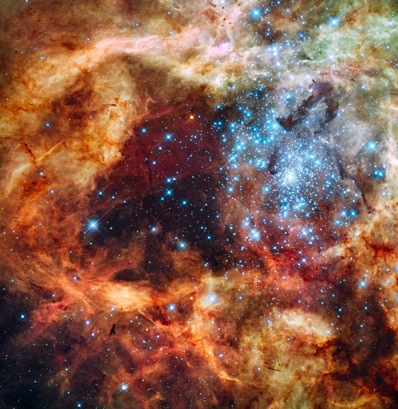



|

|

A festive treat from Hubble
DR EMILY BALDWIN
ASTRONOMY NOW
Posted: December 15, 2009


In time for the festive season, Hubble scientists have revealed a new image complete with a Christmas tree silhouette carved into a nebula awash with brilliant blue stars and warm glowing clouds.
 In this image of 30 Doradus, blue light is from the hottest most massive stars, green from the glow of oxygen and red from fluorescing hydrogen. NASA, ESA, F. Paresce (INAF-IASF, Bologna, Italy), R. O’Connell (University of Virginia, Charlottesville), and the Wide Field Camera 3 Science Oversight Committee. In this image of 30 Doradus, blue light is from the hottest most massive stars, green from the glow of oxygen and red from fluorescing hydrogen. NASA, ESA, F. Paresce (INAF-IASF, Bologna, Italy), R. O’Connell (University of Virginia, Charlottesville), and the Wide Field Camera 3 Science Oversight Committee.
The stellar grouping, R136, is just a few million years old and is located in the 30 Doradus Nebula within the turbulent star-forming region of the Large Magellanic Cloud (LMC). The icy-blue coloured stars are some of the most massive known, weighing in at over 100 times that of our own Sun. These stars will die in cataclysmic supernova explosions in a few million years time, but at present these brilliant stars are burning deep cavities into the surrounding material with their powerful ultraviolet radiation, producing a turbulent landscape of pillars, ridges and valleys.
There is even a festive Christmas tree-shape standing out in the centre of the image as a dark region against the warm, red nebulosity of glowing hydrogen gas. The tree appears to be lit up with strands of blue lights and a red star shining at top.
As well as dominating the shapes that reside within 30 Doradus, the young stars are also contributing to the formation of future generations of stars. When their energetic winds strike dense walls of gas they create shocks that trigger new waves of star birth.
The LMC is a satellite galaxy of the Milky Way and its movement around our Galaxy and its interaction with the companion Small Magellanic Cloud could have triggered the formation of the massive star cluster by compressing gas in the LMC, building up enough pressure to provoke star formation. Star birth and galaxy interactions were common in the early Universe, and this cluster provides a rare, nearby example of such activity.
The new image was taken in ultraviolet, visible and red light by Hubble's new Wide Field Camera 3 between 20 and 27 October, and spans about 100 light years.
|

|

|

|
|



